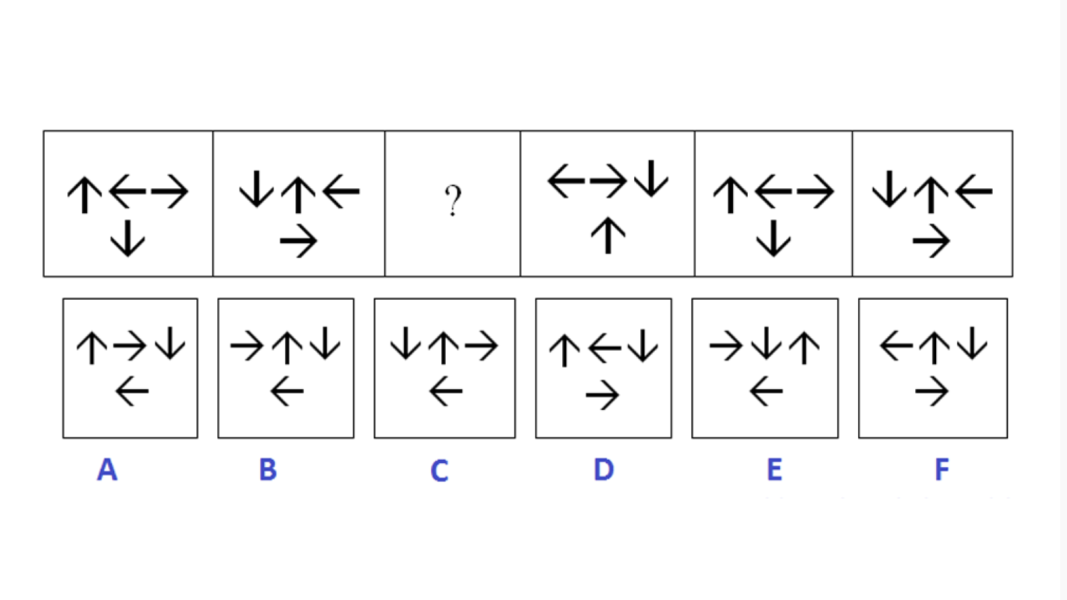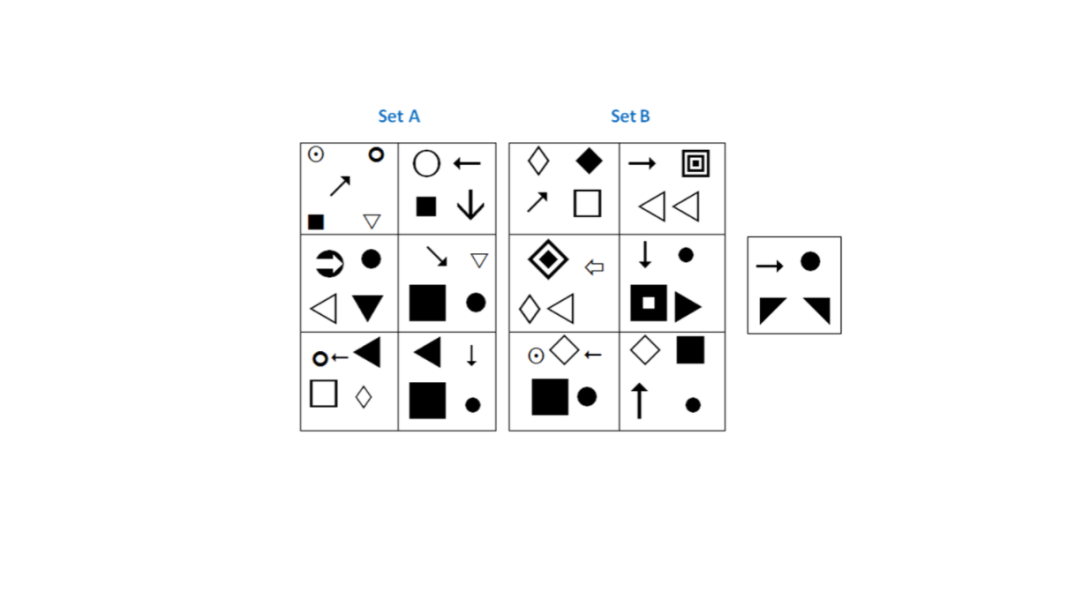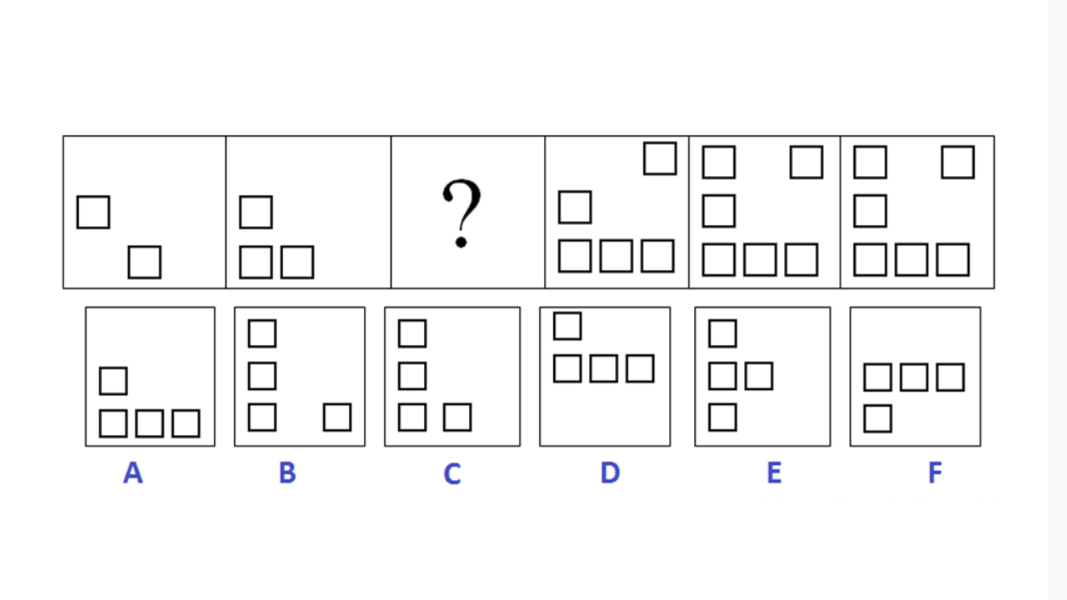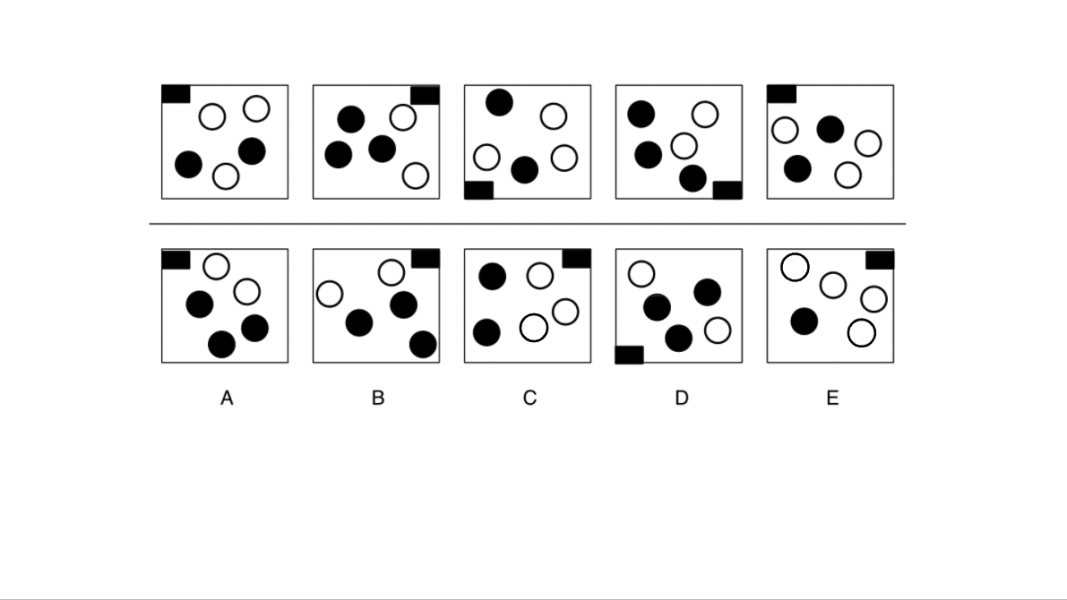What is a diagrammatic reasoning test?
Diagrammatic reasoning tests assess your capacity for both inductive reasoning and deductive reasoning.
They focus on your ability to apply premises and draw conclusions – testing logic, speed and accuracy under time pressure.
As they rely on a candidate’s interpretation of sequences and patterns, rather than numbers or words, they are seen to test pure reasoning ability. Their results are therefore considered to be less influenced by educational background than those of verbal reasoning or numerical reasoning tests.
Diagrammatic reasoning does not require any prior knowledge, but preparation and familiarity with the test content and format will help you to achieve a better score.
In a diagrammatic test, you will be required to infer the rule (or set of rules) that governs a given sequence, and then apply this logic to a new scenario to find the correct answer.
The diagrams in the questions commonly display inputs and outputs, along with the operations or processes that have taken place. It is important to apply these processes in the order in which they are presented.
Diagrammatic tests used in the application process are considered tricky by many candidates, since diagrammatic reasoning is not a skill commonly used in everyday life. The tests do, however, give a good insight into your critical thinking, intellectual ability and problem-solving ability – which employers place great value upon.
How are diagrammatic tests different to logical and abstract tests?
The terms for many psychometric test types are used interchangeably, which can be confusing when you are trying to prepare. There are, however, some subtle differences between an abstract reasoning test and a diagrammatic reasoning test.
Abstract reasoning questions challenge candidates to determine the underlying logic in sequences of shapes or symbols. The questions centre on identifying relationships, completing the sequences and selecting the odd one out. These questions are closer to those found in an IQ assessment.
Diagrammatic reasoning questions are a little more complex. While they may include some questions similar to the above, they predominantly contain questions that use operators and processors and require candidates to make deductions which they then apply to new sequences.
Logical reasoning tends to be used as an umbrella term and encompasses both abstract and diagrammatic testing. Also commonly found under this umbrella are critical thinking or reasoning tests, inductive reasoning, deductive reasoning tests and analytical reasoning tests. (Note here that analytical reasoning tests are a term used to refer to both verbal and non-verbal assessments.)
If you’re taking a logical reasoning test and are confused as to what it may contain, it is worth asking your contact in the recruitment process if any further information is available.
A diagrammatic reasoning test is a multiple-choice assessment. It will most likely consist of around 30 questions, which are required to be answered within a given time limit.
It is common to have around one minute to answer each question. This is worth double-checking in advance though, so you know the exact parameters you are working within. Practising answering the questions accurately and at pace will be key to achieving a high score.
Some tests give the allotted time freely, whereas others structure the time, so you have a certain amount to answer each question before moving on to the next.
Questions usually increase in difficulty as you progress through the test. This means that the rules that govern the problems will become more challenging and complex to apply, and multiple logic may relate to a single sequence.
Unlike some other forms of psychometric testing, the content of a diagrammatic reasoning test is not dependent upon the field or role to which you are applying. The format is standard across all industries.
The format of the test and question types may vary slightly according to the test publisher but, with adequate preparation, there should not be any challenges you cannot handle on the day.
To accustom yourself to the general format of diagrammatic tests, we recommend completing our free diagrammatic reasoning test (with answers provided).
Why do employers use diagrammatic reasoning tests?
Employers like to use diagrammatic reasoning tests as they are an effective method for rapidly shortlisting candidates from a large recruitment pool. They are a means of revealing strengths and weaknesses, and fairly assessing candidates on relevant job criteria.
They may be used by employers at a very early stage of the recruitment process – as an initial screening to determine which candidates should advance – or may be part of a later assessment centre.
In the latter case, diagrammatic reasoning tests will likely make up only one part of the assessment, complemented by other types of psychometric test such as numerical or verbal reasoning, or situational judgement assessments.
Diagrammatic tests assess a potential employee’s ability to think laterally, and logically and apply concepts to new situations, indicating future performance in a role requiring analytical and complex problem-solving.
Research indicates a positive correlation between high performance in diagrammatic reasoning tests and subsequent job success, instilling confidence in employers regarding the reliability of these assessments.
How to prepare for diagrammatic reasoning tests
As with all other types of psychometric testing, dedicated preparation is key to achieving a high score on a diagrammatic reasoning test.
The diagrams in the test questions are outside of anything we regularly encounter, so it is important to familiarise yourself with their format, aesthetic and logic they are testing.
Practise for the test by working your way through sample questions in similar conditions to those in which you will sit the final test. Working somewhere quiet with few distractions will help you to focus on grasping the reasoning and improving your mental agility.
Prepare by logically approaching the questions, first working through the processes of the sequence, then looking at the multiple-choice answers offered. If you start from the answer options and work backward, you are likely to become confused and not fully grasp the logic governing the problem.
It is also crucial to practise keeping to time. Use a stopwatch or phone timer so you are aware of the amount of time you have remaining and can adjust your pace accordingly.
Always review any incorrect answers carefully to understand where you went wrong. This will ensure you actively learn from the practise and can apply your improved reasoning skills next time around.
As the access to test material is vital for adequate preparation, Practice Aptitude Tests has a free diagrammatic reasoning test to get you started. We also have over 30 full diagrammatic tests available, along with solutions and explanations.
Common diagrammatic test publishers
There are numerous publishers of diagrammatic tests and each has variations in its test format and content. These differences are usually in the form of question framing or test length.
The most common diagrammatic test publishers are:
Cubiks
The Cubiks RfB (Reasoning for Business) series contains one of the diagrammatic reasoning tests most commonly used by employers.
This test measures the ability of candidates to analyse and draw logical inferences from diagrammatic data. There are 60 questions to answer in a time limit of 30 minutes.
Saville Assessment
Saville Assessment is a popular publisher of diagrammatic reasoning tests. It provides a stand-alone diagrammatic test, as well as a shorter diagrammatic reasoning assessment embedded in its combined Swift series test. The full diagrammatic reasoning test has an allocated completion time of 24 minutes to answer 32 questions.
It is sensible to try and discover who the provider of your test will be, so you can accustom yourself to the particularities of the test. If this information is not available, don’t panic – the overall concepts and guiding principles remain the same across all test publishers.
If you know your test publisher, Practice Aptitude Tests usefully provides access to practice tests according to test type or publisher - particularly handy if you are preparing for an assessment centre.















